Red Wolves once roamed across the modern southeastern United States, but by 1970 they had been all but wiped out. Treated as a nuisance, the species was hunted for decades until only a handful lived in the wilds of southern Texas and Louisiana.
 In 1973, the U.S. Fish & Wildlife Service launched an ambitious conservation program, capturing the remaining Red Wolves and breeding a new generation of the species. Declared extinct in the wild in 1980, Red Wolves were successfully reintroduced in 1987 thanks to the success of this captive breeding program.
In 1973, the U.S. Fish & Wildlife Service launched an ambitious conservation program, capturing the remaining Red Wolves and breeding a new generation of the species. Declared extinct in the wild in 1980, Red Wolves were successfully reintroduced in 1987 thanks to the success of this captive breeding program.
Although the population peaked at over 120 wild Red Wolves in 2012, today there are fewer than 25 animals roaming North Carolina, and their future is threatened. Their current habitat is only three feet above sea level, leaving them critically vulnerable to climate change. Furthermore, human-caused events, specifically gunshots and vehicle strikes, are the leading causes of Red Wolf mortality and population decline in the wild.
Our Work
In coordination with our state affiliate, North Carolina Wildlife Federation, and other conservation partners, National Wildlife Federation is continuing to support Red Wolf recovery efforts in the Albemarle Peninsula of North Carolina.
The National Wildlife Federation uses its full range of communications and educational tools to support outreach across the country to increase the visibility of the Red Wolf’s plight, and the continued need to support conservation for this critically endangered mammal.









